 |
 |
FACULTY:
Neil Churcher, Michael Kieslinger, Molly wright Steenson, Jan Christoph Zoels
Team:
Steven Blythe, Ruth kikin-Gil, Maya Lotan
|
 |
|
 |
Room Mates : Interaction concept
|
|
 |
The design challenge we were facing was to see if this framework can support people in delicate social situations like:
: : Social Juggling: Making plans for the same time slot with different groups of people.
: : The committee: Making good friends part of an event, without actually being there.
: : Drying someone out: Withholding information and communication from a certain person, trying to hint he is not wanted...
We developed a conceptual interaction and interface approach that focuses on people and the communications between them. the following sketches illustrate these concepts:
|
 |
 |
PEOPLE: selecting friends from a contact book (main view) and going into a specific room
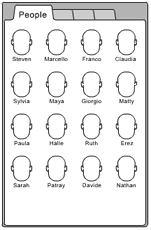 |
 |
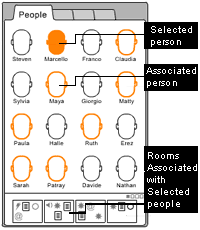 |
 |
 |
 |
| 1. This is John's address book. He wants to communicate with his friends Marcello, Claudia and Giorgio. |
 |
2. Marcello is the first person to be selected.
All the other people that appear in any room with John and Marcello, are highlighted to allow quick selection path.
The Room thumbnails appear in the bottom of the screen and serve both as a visual reference and as a shortcut for entering the group's shared space.
|
 |
|
| |
 |
 |
 |
 |
 |
 |
 |
 |
 |
3. When John added Claudia to the selection, the number of highlighted people decreased as there are less people associated with all three of them.
The number of the available rooms has diminished accordingly |
 |
4. Then, John selected Giorgio, who was not a part of any room combination with the other friends.
The selection recommendations and the room thumbnails disappeared.
Instead, a room entry option appears. |
 |
 |
Within the ROOM: Room view, switching between rooms
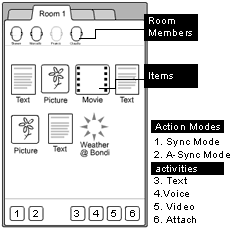 |
 |
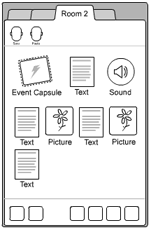 |
 |
|
 |
1. This is John, Marcello, Claudia and Giorgio's shared room. Their pictures appear on the top, and serve both as an indication and as a shortcut to enter other rooms which contain part of this room's participants.
The items are all the communications that the room member share: text and voice messages, Images and videos, information items, event capsules etc.
The room members can act in sync mode and initiate text, voice and video conversations with the room members, or leave messages in different forms in the A-sync mode.
|
 |
2. The group is discussing going to a movie together the next day.
At the same time Giorgio and Claudia are having another conversation in their shared room, trying to decide if they will watch the movie with their friends, or maybe go to a bar, just the two of them.
Switching between rooms is done by moving between the room tabs.
|
 |
|
ITEM related: selecting an item, viewing item's content , navigating item's layers
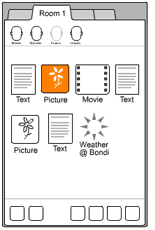 |
 |
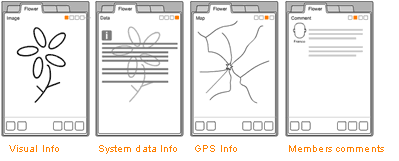 |
 |
 |
All items are accessible to all room members. They can select any item and view its content.
Item's information layers can be generated by the system (I.e.: date and time info, Geographic location data etc.) or by the user (i.e.: text or voice comments) |
 |
 |
Next step: VALUE PROPOSITION
|
 |
|
